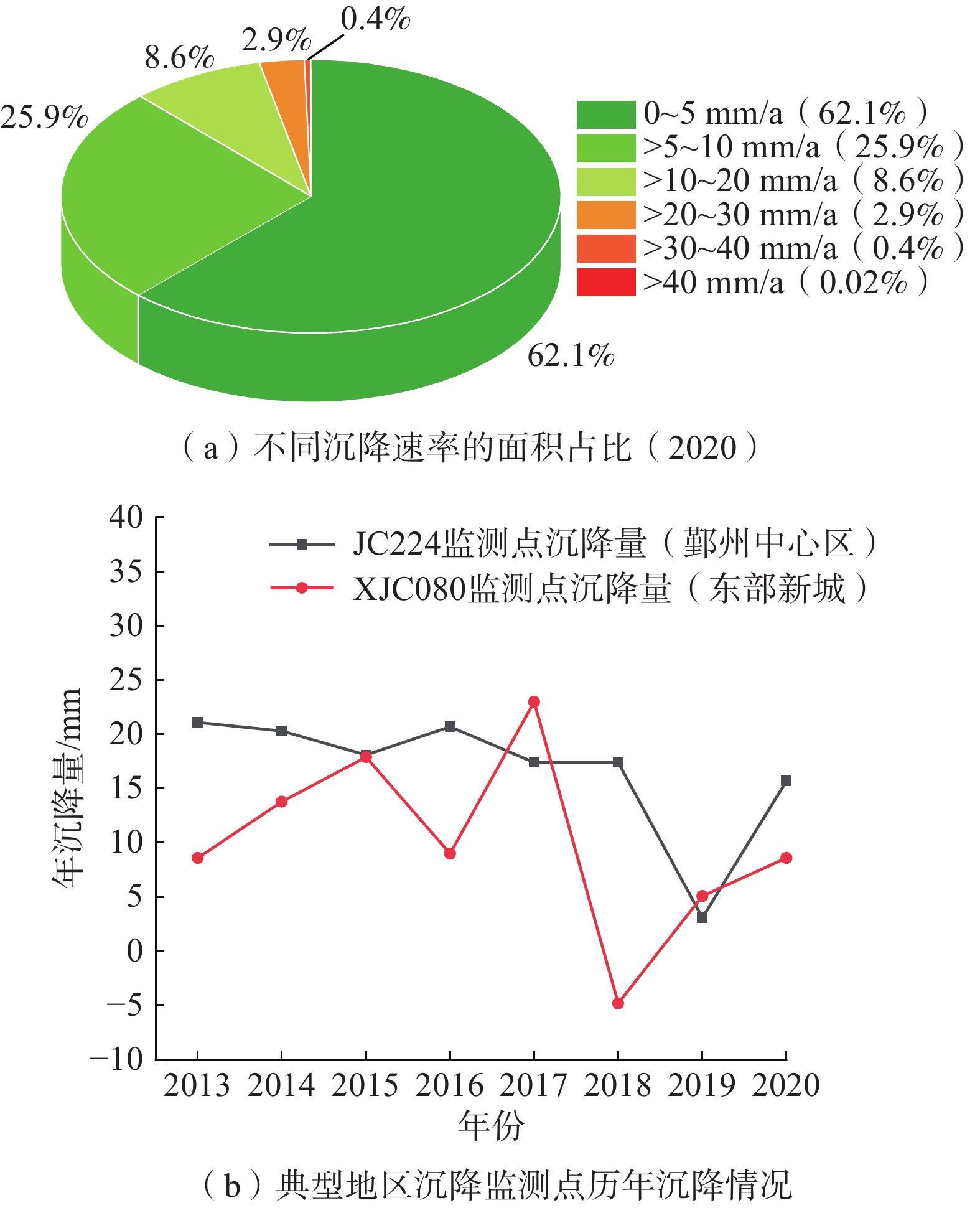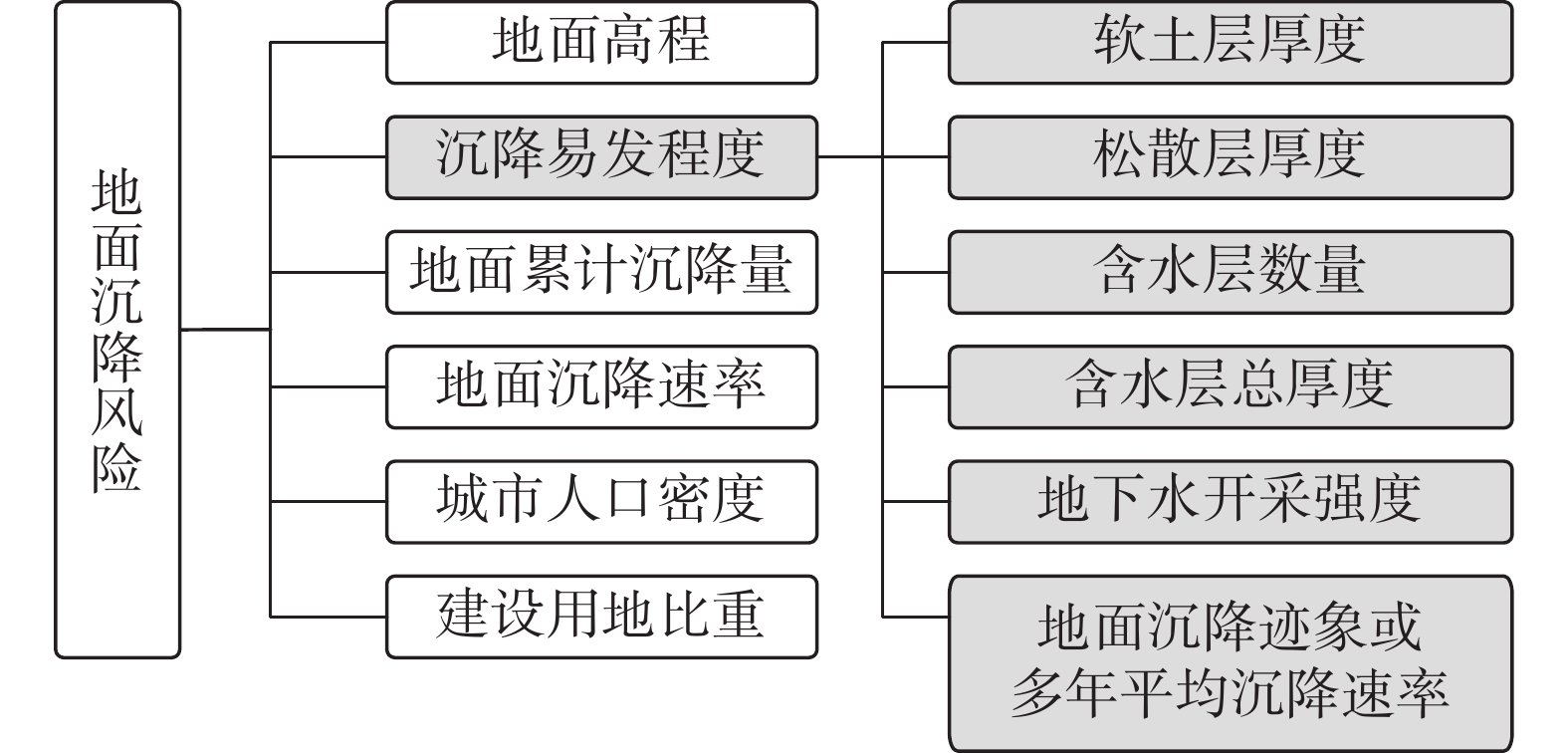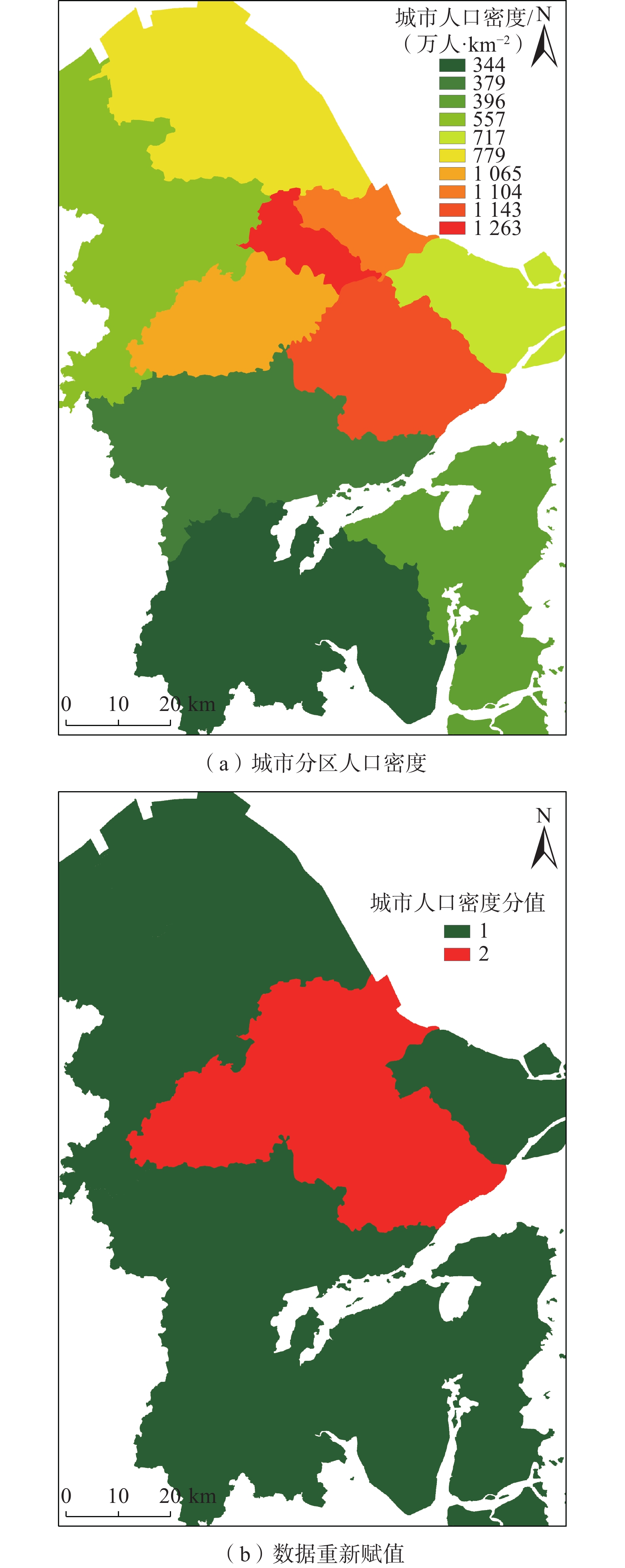Analysis and risk evaluation of current land subsidence in Ningbo City
-
摘要: 针对宁波市地面沉降发展现状及风险评价需求,结合2017—2020年的InSAR遥感监测数据与沉降点监测数据,对近年地面沉降特征进行了分析。在此基础上建立了包括地面高程、沉降易发程度、地面累计沉降量、沉降速率、城市人口密度、建设用地占比重等6个评价因子为主的地面沉降风险评价体系。其中沉降易发程度为综合考虑地质条件、水文地质条件、人为活动影响后的综合性评价因子。地面沉降风险评价结果表明:宁波市地面沉降无高易发区,中、低易发区主要与区内全新世软土层厚大、历史上大量开采地下水、局部高强度城市建设以及沿海围垦工程等因素有关。最后,划分了地面沉降中风险区、低风险区、风险防控带,并提出了相应的地面沉降风险区管控建议。Abstract: In response to evaluating the current status and assessing the risk assessment requirements of land subsidence in Ningbo City, the characteristics of land subsidence in recent years were analyzed using InSAR remote sensing monitoring data and subsidence point monitoring data from 2017 to 2020. Based on this analysis, a land subsidence risk assessment system has been developed, primarily consisting of six evaluation factors, including ground elevation, susceptibility to subsidence, cumulative ground subsidence, subsidence rate, urban population density, and the proportion of construction land usage. The susceptibility to subsidence is a comprehensive evaluation factor that takes into account geological conditions, hydrogeological conditions, and the impact of human activities. The results of the land subsidence risk assessment indicate that there are no high-risk susceptibility zones for land subsidence in Ningbo City. Medium and low-risk susceptibility zones are primarily associated with factors such as the thick layers of the Holocene soft soil, historical excessive groundwater extraction, localized high-intensity urban development, and coastal land reclamation projects within the region. Finally, the areas were categorized into medium-risk, low-risk, and risk prevention zones, along with corresponding control recommendations for land subsidence risk management.
-
0. 引言
滑坡是一种频繁且严重的地质灾害,极大地威胁着人民的生命财产安全[1-2]。天然碎石土边坡分布广泛,尤其是在南方山地丘陵地区,在发生的各类滑坡中,碎石土滑坡占比接近80%[3-6]。许多学者对砂质和岩质边坡的稳定性开展研究,并取得不少成果,然而针对碎石土边坡的成果十分有限。因此,有必要对碎石土边坡的失效机理进行研究,为评估其稳定性提供合理的参考。
众多研究人员对碎石土边坡开展了大量的研究并取得了显著的研究成果,主要集中在理论分析、数值分析、试验研究三个方面。极限平衡法是边坡稳定性分析最早也最常用的一种理论分析方法,其理论基础是莫尔-库伦强度准则和静力平衡原理分析边坡破坏模式下的受力状态,根据边坡潜在破坏面的滑移体上沿剪切方向的抗剪力和剪切力之间的关系来计算边坡的安全系数[7-9]。然而,极限平衡法在计算过程中进行了一些假设和简化。其中之一是假设所有滑移面上的材料同时达到极限平衡状态,而实际上材料的极限平衡往往是逐步实现的。极限平衡法的另一个假设与滑动面有关。边坡的滑动面在发生破坏前通常是未知的,而在计算边坡的稳定性时,需要预先假设边坡的形状和位置,找到最小安全系数来确定一个潜在的滑移面。
随着计算机技术的发展,许多学者采用数值分析方法来研究碎石土边坡的稳定性。有限元法(finite element method,FEM)可以模拟计算处边坡的滑移面和安全系数,被广泛应用于边坡稳定性分析[10]。Napoli等[11]分别有限元法和极限平衡法对不同含石量的边坡进行了稳定性分析。庄锦亮等[12]基于FLAC3D和Janbu法计算不同内摩擦角和黏聚力边坡的安全系数,结果表明内摩擦角对边坡稳定性的影响更明显。然而,有限元法在建模时把所有介质视为连续体,当边坡由岩土或砂土组成时这一假设是合理的。然而碎石土由碎石和细粒土组成,其同时表现出连续介质和离散介质的特征,造成有限元法的这一假设变得不再合适。因此,一些研究者采用离散元法(discrete element method,DEM)来研究碎石土边坡的稳定性。离散元法假设材料是由大量的单独粒子组成的,它们可以相互独立地运动,只在接触点相互作用。李存柱等[13]基于离散单元法发现碎石的形状会影响材料宏观力学性能,并且建立了碎石形状与其宏观力学性能之间的关系。陆烨等[14]用离散单元法对碎石土边坡的稳定性进行了分析,发现碎石的含量、形状和大小会影响边坡的安全系数。但是由于需要考虑所有颗粒的相互作用,离散元法的计算效率较低。
目前关于碎石土边坡模型试验的研究较少,多数研究集中于碎石土的单元体试验。彭东黎等[15]基于大型的室内直剪试验,对含石量及含水量与碎石土黏聚力和内摩擦角的关系进行了深入研究。Wang[16]采用高能X射线计算机断层成像(CT)方法研究了三轴试验中碎石含量对碎石土细观结构变化和相关应变局部化行为的影响。王腾等人[17]用铝棒模拟砾石,对碎石土进行了平面应变试验,发现碎石主要通过转动阻力影响剪切带的发展。但是单元体试验无法重现碎石土边坡复杂的地质情况,不能准确地描述其破坏过程。
碎石土具有天然的多尺度结构,其变形和强度特性很大程度受其细观结构的影响。但目前相关研究很少从宏细观尺度深入地分析碎石土边坡的失效机制。本文基于数字图像技术,对不同含石量的碎石土边坡进行模型试验,从宏细观尺度研究碎石土边坡的失稳机制。试验结果表明,含石量对碎石土边坡的承载力和位移具有显著的控制效果,并且碎石会影响剪切带的发展。
1. 试验概况
1.1 试验装置
试验所用模型箱尺寸为600 mm×290 mm×350 mm(长×宽×高),四个面均为透明面,便于使用数码相机记录试验过程中砂土边坡侧面土体连续变形过程。加载装置为万能材料试验机,通过对边坡坡顶尺寸为100 mm×290 mm×50 mm的加载板施加荷载,如图1所示。
1.2 试样制备
本试验中试样是粒径2~10 mm的砾石与d50为0.29 mm的福建标准砂混合配制而成的碎石土,各试样的级配曲线如图2所示。为保证局部场拍摄效果,对局部的碎石土进行染色处理。
制备试样时,首先将所需碎石砂土烘干。然后按3%的含水率加水搅拌直至均匀,为保证密度控制在1.74 g/cm3,每次称量后分层填筑进模型箱填筑,完成的模型如图3所示,坡高250 mm,坡角为50°。
1.3 图像采集
使用4240万有效像素的数码相机在试验期间连续拍摄,捕捉全场土体位移的图像,同时使用微距摄像头拍摄局部场土体变形。为了减少自然光对图像质量的影响,在试验过程中使用两个摄影灯提供照明。试验结束后,将视频中的图像提取并导入自行编制的图像处理程序进行计算。
2. 试验结果及分析
2.1 坡顶荷载-沉降曲线
为了减少壁面摩擦对边坡承载力的影响,在模型箱的壁面涂抹凡士林作为润滑剂。图4为边坡的荷载与位移关系曲线和极限承载力。
从图4(a)可以看出,边坡的P-s曲线受碎石含量的影响。P-s曲线变化大致可以分为三个阶段。第一阶段,随着荷载的增加,坡顶沉降接近线性增大,坡顶砂土处于整体压密阶段。随含石量增加,曲线的斜率增加。第二阶段,随着荷载逐渐接近峰值,荷载的增长率逐渐降低。荷载达到峰值后为第三阶段,在此阶段,不同含石量的P-s曲线呈现不同的形式。当含石量小于70%时,边坡的承载力有明显的软化阶段。而含石量大于70%时,承载力在第三阶段没有明显的软化现象。并且,含石量越大,边坡达到承载力峰值的位移越大。边坡的极限承载力也就是试验中的峰值承载力,本文中T为加载时刻至边坡的极限承载力总时间。表1列出不同含石量的碎石土边坡所需的总时间T,从中可以看出随含石量增加,荷载达到极限承载力所需的时间逐渐增加,但是在低含石量和高含石量时,增加幅度较小。
表 1 不同含石量碎石土边坡总时间(T)Table 1. Time of gravel soil slope with different stone contents含石量/% T/s 含石量/% T/s 0 150 50 535 10 189 60 624 20 224 70 700 30 295 80 715 40 426 图4(b)比较了不同含石量边坡的极限承载力。从图中可以看出,边坡的极限承载力受碎石含量的影响。当含石量低于20%时,边坡受含石量的影响较小,这是由于此时碎石土的力学性质主要依赖于砂土,碎石悬浮在砂土之中,对边坡的极限承载力贡献较小。而当含石量高于20%且小于70%时,边坡的极限承载力随含石量增大而急剧增加,此时边坡内的碎石形成骨架结构,承载力受碎石的影响突显,承载力由碎石和砂土共同承担。而当含石量达到70%时,边坡内的碎石形成了架空结构,边坡中的砂土悬浮在碎石间,碎石土的力学性质更接近于岩体;在此基础上含石量增加,极限承载力基本没有改变。因此含石量对边坡承载力的影响存在两个阈值,下阈值为20%,上阈值为70%。
2.2 不同含石量位移云图分析
根据含石量对边坡极限承载力影响的上、下阈值,本文选取了三个区间中各一含石量的碎石土边坡进行研究,即含石量为10%、50%和80%。将试验过程中拍摄的视频每5 s截取一张图像用于DIC的相关计算,得到边坡的位移增量。图5为不同含石量边坡达到极限承载力时的位移矢量增量,图中箭头方向为土体发生位移的方向,箭头的长度代表土体位移的大小。
从图5可知,在边坡达到极限承载力时,不同含石量碎石土边坡的土体位移趋势是一样的。在加载板下方,位移矢量的方向靠近垂直方向,该区域的土体主要发生竖直位移。越靠近临坡面,位移矢量接近水平,土体位移以水平方向为主。根据土体的变形情况可以分为三个区域:稳定区、剪切区和滑移区。在稳定区,土体几乎没有发生位移,位移矢量呈现点状;在滑移区,土体发生较大的位移,并且以水平位移为主;剪切区介于稳定区和滑移区之间,剪切区的范围很窄,但位移梯度变化很大。比较不同含石量边坡的位移矢量长度可以发现,边坡的位移增量随着含石量的增加而减小,这是因为含石量增加,碎石之间的接触逐渐增加并形成碎石骨架,碎石土的内摩擦角增大,边坡抵抗变形的能力增强,因此其位移增量减小。
以位移增量0.02 mm作为土体发生变形的范围,画出位移包络线,如图6所示。从图中可以看出含石量增加,土体发生变形的范围越大。这是由于碎石之间互相嵌固,机械咬合力增大,边坡碎石发生位移和旋转时会带动更大范围内碎石土受力变形,因此随着含石量的增加,土体发生位移的范围也更大。对比不同含石量的边坡位移包络线形状可以发现含石量增大,包络线形状变得不规则且曲折。主要原因是碎石的强度和刚度都较大,土体变形的滑移面往往会沿着强度和刚度相对更低的碎石与碎石、碎石与砂土的接触面发展,从而导致其位移包络线变得曲折。
2.3 剪应变云图分析
当荷载达到峰值后边坡发生失稳破坏,部分土体会沿着某一滑动面突然出现明显的运动,这个滑动面称之为剪切带,而这个滑移面的附近发生显著的应变局部化现象。图7为不同含石量碎石土边坡达到极限承载力时剪应变增量云图,以逆时针为正。
由图7可以看出,碎石会影响边坡中剪切带的发展。当含石量为10%时,边坡内只有一条主剪切带,在滑移体内只有少量的剪应变较大的部位,剪切带也较为平顺光滑。而当含石量较高时,滑移体内的次剪切带随着含石量的增加而逐渐增多,并且剪切带形状变得曲折不规则。这是由于碎石的本身的强度和刚度较高,导致剪切带在发展路径经过碎石骨架时,会沿着碎石与碎石、碎石与砂土的接触面发展,因此剪切带可能发生绕石或分叉,从而在滑移体内产生多条次剪切带。
3. 局部场结果及分析
3.1 局部场剪应变云图分析
当含石量较低时,碎石悬浮在砂土之中,而含石量较高时碎石形成了架空结构,边坡中的砂土悬浮在碎石间。因此本节选择了含石量50%碎石土边坡的局部场作为研究对象,在该含石量时碎石与砂土共同承担上部荷载,两种材料间的相互作用更加复杂,更能揭示碎石和周围砂颗粒的细观行为对剪切带发展的影响。图8分别拍摄了含石量50%碎石土边坡的上部和下部局部场图像,上部局部场在后文中称为局部场一,其计算区域尺寸为84 mm×48 mm;下部局部场为局部场二,其计算区域尺寸为44 mm×28 mm。
局部场土体发生剪切破坏时,会出现明显的应变局部化。图9为不同时刻局部场剪应变增量云图。由图9可以发现,在1/4T时刻,局部场一土体没有变形,此处剪切应变增量值几乎为零。而加载到1/2T时,在滑移面出现了应变局部化现象,并且剪应变连接并贯通局部场一,说明此时局部场一已经发生了剪切破坏。在剪切带外的滑移区内,分布着剪应变较大的单元。随着荷载变大,滑移区内剪应变较大的单元变多,部分形成次剪切带。这是由于碎石影响了剪切带的发展路。与局部场一相比,局部场二的剪切带形成时间更晚,在3/4T时刻时,才能看到明显的应变局部化现象。
对比全场的剪应变增量云图,可以发现在高含石量的边坡内,剪切带往往从开始的只有一条或两条主剪切带逐渐发展成“一主多次”的剪切带形式。这说明碎石对剪切带的发展有明显的影响作用。
3.2 碎石对剪切带发展的影响
为了明确碎石对剪切带的影响,选取了局部场一中有代表性的区域进行放大,如图10所示。图中虚线红框中为选定区域,并进行编号S1~S6。
在放大的区域,用黑色虚线描出碎石边界,用红色虚线会出剪切带位置,如图11所示。从图中可以看出,当剪切带经过碎石时,剪切带会出现几种不同的绕石模式。S2和S3处图中可以看到当剪切带经过碎石时,发生了单边绕石,碎石左右两侧都可能是剪切带的绕石方向。S1、S5和S6中剪切带的绕石方式是分叉,由一条剪切带分叉成两条甚至多条剪切带。对比这两种模式可以发现,当剪切带发展的方向与碎石的长轴方向成锐角时,剪切带大概率会以分叉的模式继续发展,当剪切带发展的方向与碎石的长轴方向成钝角时,剪切带会以单边绕石的模式继续发展,发展方向取决于碎石和剪切带之间的位置关系。S1、S3、S4和S6可以看到当发生这两种绕石模式时,剪切带会穿越碎石与碎石接触面。
选取S6区域中2个碎石和其周边20个砂土颗粒描绘出其在不同时刻的质心坐标和长轴角度,进一步验证碎石对剪切带的影响,如图12所示。X和Y轴均为图像的像素坐标,颗粒边上数字为编号,碎石1~2,砂颗粒1~20。两个碎石在1/4T时相互接触形成骨架,砂颗粒1~17分布在碎石骨架外,砂颗粒18~20位于碎石骨架内。当加载到1/2T时刻时,碎石和砂颗粒发生的位移和旋转角度都较小,两个碎石逐渐分开,砂颗粒与碎石的相对位置没有明显改变。继续加载,位于上方的碎石和砂颗粒出现了比较明显的位移和旋转角度,而下方的碎石基本没有运动。此时砂颗粒和碎石之间的相对位置发生改变,有部分砂颗粒沿着碎石左侧运动,在碎石之间有砂颗粒挤入碎石骨架,剩余的砂颗粒沿着下方碎石的右侧运动。碎石影响了土体变形,滑移面由一个分叉成多个滑移面。
通过对像素标定,即一个像素值等于0.05 mm,计算得到各颗粒实际位移值,位移以向下为正和向右为正,旋转角度以逆时针为正,如表2所示。从表中可以看出,砂颗粒的位移和旋转角度大于碎石。碎石和周边的砂颗粒的运动行为存在差异,主要原因是一方面是当含石量为50%时,尽管碎石形成骨架结构与砂颗粒一起承受荷载,但是砂颗粒仍是主要的承力介质,导致砂颗粒发生更剧烈的运动,另一方面是碎石的内摩擦角比砂颗粒更大,碎石的运动明显弱于砂颗粒。碎石与周边砂土运动行为不协调,使得砂颗粒会沿着碎石边缘或者碎石之间的接触面运动。这也是碎石影响剪切带发展的原因之一。
表 2 颗粒位移和旋转角度Table 2. Summary table of the particle displacement and rotation angle颗粒 水平位移/mm 竖直位移/mm 旋转角度/(°) 颗粒 水平位移/mm 竖直位移/mm 旋转角度/(°) 碎石1 3.87 5.17 16 砂颗粒10 2.75 8.25 −36 碎石2 1.75 3.01 1 砂颗粒11 1.78 5.93 −20 砂颗粒1 7.88 8.54 122 砂颗粒12 2.84 7.40 −25 砂颗粒2 8.90 7.30 110 砂颗粒13 2.04 7.20 −94 砂颗粒3 10.19 5.68 90 砂颗粒14 5.55 4.69 −80 砂颗粒4 9.41 6.94 114 砂颗粒15 4.69 4.28 117 砂颗粒5 9.25 5.98 50 砂颗粒16 5.41 4.62 56 砂颗粒6 8.39 4.31 52 砂颗粒17 2.41 3.91 77 砂颗粒7 5.74 7.67 22 砂颗粒18 2.14 6.35 −22 砂颗粒8 4.26 4.5 160 砂颗粒19 3.31 4.24 30 砂颗粒9 7.23 1.71 10 砂颗粒20 2.70 3.92 −45 对各个区域颗粒的运动分析,总结出碎石对剪切带发展路径影响的五种绕石模式,如图13所示,箭头为剪切带的发展方向。对比这五种剪切带的绕石模式,可以发现碎石会导致剪切带影响的范围变广,长度变长,从而提高了边坡的抗滑能力,提高了边坡的稳定性,增加了边坡的极限承载力。
3.3 局部场孔隙率分析
当碎石土发生剪切破坏时,碎石骨架发生破坏和重构导致孔隙率改变。研究土体破坏过程中孔隙率的变化,有利于了解碎石土的破坏机制。
图14给出了局部场一和局部场二不同区域孔隙率的时程曲线。从图14(a)可以发现,局部场一的碎石土在未加载时,孔隙率为0.31左右。随着荷载增加,局部场一整体的孔隙率开始缓慢减小。这是因为一开始边坡处于整体压密的阶段,使得孔隙率降低。当加载到0.46T左右时,此时孔隙率最小,为0.28左右。稳定区的孔隙率在此之后开始保持稳定,说明局部场一已经完成压密。而剪切带的孔隙率开始突然增加,增长趋势维持0.18T左右,在图中用虚线标出,此时孔隙率达到0.35左右,然后在这一值上下波动。剪切带的形成过程中,碎石颗粒会发生位移、旋转等运动导致土体的孔隙率产生变化,因此剪切内孔隙率时程曲线的拐点可以认定为剪切带的初始化时间,孔隙率变化的这段时间可以看作剪切带的形成过程。滑移区的孔隙率在0.46T后和剪切带一样,开始突然增加,不过达到稳定时的值小于剪切带,为0.32左右。这是因为滑移区内也出现次剪切带,从而导致了孔隙率上升。局部场二的孔隙率的变化趋势与局部场一相似,不过局部场二剪切带的孔隙率在大约0.65T时才突然增大,并且剪切带发展的时间为0.11T比局部场一更短。这说明边坡剪切带发展是一个逐渐加速过程。
4. 结论
本文基于数字图像技术,通过静力超载法对碎石土边坡进行模型试验,从宏细观角度研究了碎石土边坡的失稳机制,得到以下几点结论:
(1)含石量会影响碎石土边坡的承载力和变形特性且存在两个阈值,下阈值为20%,上阈值为70%。当含石量小于20%时,极限承载力随着含石量增大而缓慢提高,边坡受含石量的影响较小;当含石量高于20%且小于70%时,边坡的极限承载力随含石量增大而急剧增加;当含石量大于70%时,含石量增加,极限承载力增加较小。
(2)碎石会影响边坡的土体变形和剪切带的发展。碎石与周边砂颗粒的运动行为存在差异,使得剪切带在经过碎石骨架时,其发展路径存在五种不同的绕石模式。
(3)在剪切前,碎石土的孔隙率会因为边坡被压密而逐渐减小。在剪切后,由于强烈的剪切应变和碎石土骨架的破坏重构,剪切带内的孔隙率在剪切过程中突然增大,并在剪切带形成后稳定。可以通过孔隙率的变化研究剪切带的初始化和发展。
-
表 1 地面沉降风险区划影响因素数据来源
Table 1 Data sources of influencing factors for land subsidence risk zoning
序号 沉降带名称 沉降中心 1 杭州湾—泗门沉降带 前湾新区余姚泗门 2 龙山—澥浦—招宝山沉降带 镇海化工区 3 新碶—霞浦—大榭沉降带 新碶大榭沿海区域 4 瞻岐—春晓—梅山沉降带 大嵩新区、春晓梅山围填海区 5 余姚凤山—阳明—
河姆渡沉降带凤山、阳明街道 6 骆驼—庄桥—洪塘—
高桥—集士港沉降带骆驼、庄桥、洪塘街道、
高桥、集士港镇7 东部—鄞南—江口—
西坞沉降带高新区、东部新城、南部商务区、
江口、西坞街道8 环象山港沉降带 奉化莼湖、松岙、象山西周、贤庠 9 新桥—东陈—丹城—
大徐沉降带新桥、大目湾新城、大徐 10 长街—高塘—南田沉降带 南部滨海新区、象山高塘、南田 表 2 地面沉降风险区划影响因素权重及分级
Table 2 Weight and classification of factors influencing land subsidence risk zoning
影响因素 权重
(aj)影响因素分级及分值(bj) 3 2 1 地质条件 地面高程/m 0.2 <2 2~4 >4 易发程度 0.1 高易发 中易发 低易发 沉降特征 地面累计沉降量/mm 0.2 >1 000 500~1 000 <500 沉降速率/(mm·a−1) 0.3 >40 20~40 <20 社会经济
发展指标城市人口密度/(万人·km−2) 0.1 0.2 0.1~<0.2 <0.1 建设用地比重/% 0.1 >60 30~60 <30 表 3 地面沉降风险区等级划分表
Table 3 Classification table of land subsidence risk zone levels
风险区等级 高风险区 中风险区 低风险区 地面沉降综合风险指数(W) >2.5~3.0 1.5~2.5 <1.5 表 4 地面沉降风险区划影响因素数据来源
Table 4 Data sources of influencing factors for land subsidence risk zoning
数据名称 单位 数据来源 地面高程 m 2019年宁波市各区县高程数字模型
(1∶10 000 DEM)易发程度 依据《地质灾害危险性评估规范》
(DB33/T 881—2012)的计算结果地面累计
沉降量mm InSAR遥感监测数据与沉降点监测数据 沉降速率 mm·a−1 InSAR遥感监测数据与沉降点监测数据 城市人口
密度万人·km−2 宁波市统计年鉴(2020) 建设用地
比重% 第三次全国国土调查成果(2020) 表 5 宁波市地面沉降风险区管控建议一览表
Table 5 Summary of control recommendations for ground subsidence risk zones in Ningbo City
风险区等级 面积/km2 管控建议 地面沉降
中风险区132.6 ①严格执行地下水禁、限采区管理要求;
②进一步完善“空天地一体化”监测网络,提高地下水位、地面沉降监测频率,提高围填海区域的监测点密度;
③加强重大工程建设项目地面沉降综合防治方案制定;
④加强地面沉降网络和数据库建设,形成与城市线状市政工程建设、运营单位的沉降监测数据共享,各方协同防治沉降的机制地面沉降
低风险区2 214.8 ①继续严格贯彻地下水禁、限采区管理要求;
②进一步完善和优化地面沉降和地下水监测网络,加强日常监管;
③合理布局城市建设规划,加强深基坑等工程建设活动引发的地面沉降监测与管理地面沉降
风险防控带①加强高铁、轨道交通沿线两侧的地下水开发利用及邻近工程降排水管理;
②推进沿线地面沉降监测及系统预警机制建设,加强建设与重大工程密切相关的浅部含水层地下水监测井,完善地面沉降监测网络。 -
[1] 王福刚,梁秀娟,于军. 可视化地层模型信息系统在地面沉降研究中的应用[J]. 岩土工程学报,2005,27(2):219 − 223. [WANG Fugang,LIANG Xiujuan,YU Jun. The application of the information system of visualized strata model to the research of land subsidence in Suzhou-Wuxi-Changzhou area[J]. Chinese Journal of Geotechnical Engineering,2005,27(2):219 − 223. (in Chinese with English abstract) WANG Fugang, LIANG Xiujuan, YU Jun . The application of the information system of visualized strata model to the research of land subsidence in Suzhou-Wuxi-Changzhou area[J]. Chinese Journal of Geotechnical Engineering,2005 ,27 (2 ):219 −223 . (in Chinese with English abstract)[2] 刘传正,陈春利. 中国地质灾害防治成效与问题对策[J]. 工程地质学报,2020,28(2):375 − 383. [LIU Chuanzheng,CHEN Chunli. Achievements and countermeasures in risk reduction of geological disasters in China[J]. Journal of Engineering Geology,2020,28(2):375 − 383. (in Chinese with English abstract) LIU Chuanzheng, CHEN Chunli . Achievements and countermeasures in risk reduction of geological disasters in China[J]. Journal of Engineering Geology,2020 ,28 (2 ):375 −383 . (in Chinese with English abstract)[3] 葛伟丽,李元杰,张春明,等. 基于InSAR技术的内蒙古巴彦淖尔市地面沉降演化特征及成因分析[J]. 水文地质工程地质,2022,49(4):198 − 206. [GE Weili,LI Yuanjie,ZHANG Chunming,et al. An attribution analysis of land subsidence features in the city of Bayannur in Inner Mongolia based on InSAR[J]. Hydrogeology & Engineering Geology,2022,49(4):198 − 206. (in Chinese with English abstract) GE Weili, LI Yuanjie, ZHANG Chunming, et al . An attribution analysis of land subsidence features in the city of Bayannur in Inner Mongolia based on InSAR[J]. Hydrogeology & Engineering Geology,2022 ,49 (4 ):198 −206 . (in Chinese with English abstract)[4] 何健辉,张进才,陈勇,等. 基于弱光栅技术的地面沉降自动化监测系统[J]. 水文地质工程地质,2021,48(1):146 − 153. [HE Jianhui,ZHANG Jincai,CHEN Yong,et al. Automatic land subsidence monitoring system based on weak-reflection fiber gratings[J]. Hydrogeology & Engineering Geology,2021,48(1):146 − 153. (in Chinese with English abstract) HE Jianhui, ZHANG Jincai, CHEN Yong, et al . Automatic land subsidence monitoring system based on weak-reflection fiber gratings[J]. Hydrogeology & Engineering Geology,2021 ,48 (1 ):146 −153 . (in Chinese with English abstract)[5] 张严,朱武,赵超英,等. 佛山地铁塌陷InSAR时序监测及机理分析[J]. 工程地质学报,2021,29(4):1167 − 1177. [ZHANG Yan,ZHU Wu,ZHAO Chaoying,et al. Moniting and inversion of Foshan metro collapse with multi-temporal insar and field investigation[J]. Journal of Engineering Geology,2021,29(4):1167 − 1177. (in Chinese with English abstract) ZHANG Yan, ZHU Wu, ZHAO Chaoying, et al . Moniting and inversion of Foshan metro collapse with multi-temporal insar and field investigation[J]. Journal of Engineering Geology,2021 ,29 (4 ):1167 −1177 . (in Chinese with English abstract)[6] 张阿根,吴建中. 上海地面沉降管理对策与法制建设[J]. 城市地质,2006,1(2):55 − 59. [ZHANG Agen,WU Jianzhong. Management countermeasures and legal system construction for land subsidence in Shanghai[J]. City Geology,2006,1(2):55 − 59. (in Chinese with English abstract) ZHANG Agen, WU Jianzhong . Management countermeasures and legal system construction for land subsidence in Shanghai[J]. City Geology,2006 ,1 (2 ):55 −59 . (in Chinese with English abstract)[7] 赵团芝,侯艳声,胡新锋. 浙江宁波工程性地面沉降特征与风险区划[J]. 中国地质灾害与防治学报,2015,26(4):36 − 42. [ZHAO Tuanzhi,HOU Yansheng,HU Xinfeng. Characteristic analysis and risk zoning of engineering land subsidence in Ningbo City[J]. The Chinese Journal of Geological Hazard and Control,2015,26(4):36 − 42. (in Chinese with English abstract) ZHAO Tuanzhi, HOU Yansheng, HU Xinfeng . Characteristic analysis and risk zoning of engineering land subsidence in Ningbo City[J]. The Chinese Journal of Geological Hazard and Control,2015 ,26 (4 ):36 −42 . (in Chinese with English abstract)[8] 赵团芝,侯艳声,胡新锋. 宁波市工程性地面沉降成因分析及防治对策研究[J]. 上海国土资源,2016,37(3):60 − 64. [ZHAO Tuanzhi,HOU Yansheng,HU Xinfeng. Engineering-related land subsidence in Ningbo City:An analysis of its causes and countermeasures[J]. Shanghai Land & Resources,2016,37(3):60 − 64. (in Chinese with English abstract) ZHAO Tuanzhi, HOU Yansheng, HU Xinfeng . Engineering-related land subsidence in Ningbo City: An analysis of its causes and countermeasures[J]. Shanghai Land & Resources,2016 ,37 (3 ):60 −64 . (in Chinese with English abstract)[9] 赵庆香,黄岁梁,杜晓燕. 天津市地面沉降风险分析研究[J]. 中国公共安全(学术版),2007(3):48 − 53. [ZHAO Qingxiang,HUANG Suiliang,DU Xiaoyan. Risk analysis on land subsidence in Tianjin[J]. China Public Security (Academy Edition),2007(3):48 − 53. (in Chinese with English abstract) ZHAO Qingxiang, HUANG Suiliang, DU Xiaoyan . Risk analysis on land subsidence in Tianjin[J]. China Public Security (Academy Edition),2007 (3 ):48 −53 . (in Chinese with English abstract)[10] 胡蓓蓓,姜衍祥,周俊,等. 天津市滨海地区地面沉降灾害风险评估与区划[J]. 地理科学,2008,28(5):693 − 697. [HU Beibei,JIANG Yanxiang,ZHOU Jun,et al. Assessment and zonation of land subsidence disaster risk of Tianjin Binhai area[J]. Scientia Geographica Sinica,2008,28(5):693 − 697. (in Chinese with English abstract) HU Beibei, JIANG Yanxiang, ZHOU Jun, et al . Assessment and zonation of land subsidence disaster risk of Tianjin Binhai area[J]. Scientia Geographica Sinica,2008 ,28 (5 ):693 −697 . (in Chinese with English abstract)[11] 胡喜梅,马传明,邓波,等. 江苏省沿海地区地面沉降风险评价[J]. 地质科技情报,2017,36(2):222 − 228. [HU Ximei,MA Chuanming,DENG Bo,et al. Risk evaluation of land subsidence in coastal areas of Jiangsu Province[J]. Geological Science and Technology Information,2017,36(2):222 − 228. (in Chinese with English abstract) HU Ximei, MA Chuanming, DENG Bo, et al . Risk evaluation of land subsidence in coastal areas of Jiangsu Province[J]. Geological Science and Technology Information,2017 ,36 (2 ):222 −228 . (in Chinese with English abstract)[12] 张彭,朱邦彦,孙静雯,等. 利用多源数据分析南京市河西地面沉降风险[J]. 测绘通报,2019(11):141 − 144. [ZHANG Peng,ZHU Bangyan,SUN Jingwen,et al. Risk analysis of land subsidence in Hexi area in Nanjing based on multi-source data[J]. Bulletin of Surveying and Mapping,2019(11):141 − 144. (in Chinese with English abstract) ZHANG Peng, ZHU Bangyan, SUN Jingwen, et al . Risk analysis of land subsidence in Hexi area in Nanjing based on multi-source data[J]. Bulletin of Surveying and Mapping,2019 (11 ):141 −144 . (in Chinese with English abstract)[13] 房浩,何庆成,徐斌,等. 沧州地区地面沉降灾害风险评价研究[J]. 水文地质工程地质,2016,43(4):159 − 164. [FANG Hao,HE Qingcheng,XU Bin,et al. A study of risk assessment of the land subsidence in Cangzhou[J]. Hydrogeology & Engineering Geology,2016,43(4):159 − 164. (in Chinese with English abstract) FANG Hao, HE Qingcheng, XU Bin, et al . A study of risk assessment of the land subsidence in Cangzhou[J]. Hydrogeology & Engineering Geology,2016 ,43 (4 ):159 −164 . (in Chinese with English abstract)[14] 陈蓓蓓. 北京地区地面沉降监测及风险评价研究[D]. 北京:首都师范大学,2009. [CHEN Beibei. Study on land subsidence monitoring and risk assessment in Beijing area[D]. Beijing:Capital Normal University,2009. (in Chinese with English abstract) CHEN Beibei. Study on land subsidence monitoring and risk assessment in Beijing area[D]. Beijing: Capital Normal University, 2009. (in Chinese with English abstract)
[15] 王齐鑫,王龙平,王泽宇. 安徽阜阳中心城区地面沉降灾害风险评价[J]. 中国地质灾害与防治学报,2019,30(4):32 − 39. [WANG Qixin,WANG Longping,WANG Zeyu. Risk assessment of land subsidence in central area of Fuyang City,Anhui Province[J]. The Chinese Journal of Geological Hazard and Control,2019,30(4):32 − 39. (in Chinese with English abstract) WANG Qixin, WANG Longping, WANG Zeyu . Risk assessment of land subsidence in central area of Fuyang City, Anhui Province[J]. The Chinese Journal of Geological Hazard and Control,2019 ,30 (4 ):32 −39 . (in Chinese with English abstract)[16] 于海若,宫辉力,陈蓓蓓,等. 京津冀地区地面沉降研究进展与思考[J]. 测绘科学,2020,45(4):125 − 133. [YU Hairuo,GONG Huili,CHEN Beibei,et al. The advance and consideration of land subsidence in Beijing-Tianjin-Hebei region[J]. Science of Surveying and Mapping,2020,45(4):125 − 133. (in Chinese with English abstract) YU Hairuo, GONG Huili, CHEN Beibei, et al . The advance and consideration of land subsidence in Beijing-Tianjin-Hebei region[J]. Science of Surveying and Mapping,2020 ,45 (4 ):125 −133 . (in Chinese with English abstract)[17] 戴真印,刘岳霖,张丽平,等. 基于改进时序InSAR技术的东莞地面沉降时空演变特征[J]. 中国地质灾害与防治学报,2023,34(1):58 − 67. [DAI Zhenyin,LIU Yuelin,ZHANG Liping,et al. Temporal and spatial evolution characteristics of land subsidence in Dongguan based on improved time series InSAR technology[J]. The Chinese Journal of Geological Hazard and Control,2023,34(1):58 − 67. (in Chinese with English abstract) DAI Zhenyin, LIU Yuelin, ZHANG Liping, et al . Temporal and spatial evolution characteristics of land subsidence in Dongguan based on improved time series InSAR technology[J]. The Chinese Journal of Geological Hazard and Control,2023 ,34 (1 ):58 −67 . (in Chinese with English abstract)[18] 李佳琦,徐佳,刘杰,等. 天津地面沉降严重区分布特征及变化规律[J]. 中国地质灾害与防治学报,2023,34(2):53 − 60. [LI Jiaqi,XU Jia,LIU Jie,et al. Distribution characteristics and evolution trend of severe land subsidence areas in Tianjin City[J]. The Chinese Journal of Geological Hazard and Control,2023,34(2):53 − 60. (in Chinese with English abstract) LI Jiaqi, XU Jia, LIU Jie, et al . Distribution characteristics and evolution trend of severe land subsidence areas in Tianjin City[J]. The Chinese Journal of Geological Hazard and Control,2023 ,34 (2 ):53 −60 . (in Chinese with English abstract)[19] 王寒梅. 上海市地面沉降风险评价体系及风险管理研究[D]. 上海:上海大学,2013. [WANG Hanmei. Study on risk assessment system and risk management of land subsidence in Shanghai[D]. Shanghai:Shanghai University,2013. (in Chinese with English abstract) WANG Hanmei. Study on risk assessment system and risk management of land subsidence in Shanghai[D]. Shanghai: Shanghai University, 2013. (in Chinese with English abstract)
[20] 吴柯,张晓平,刘浩,等. 粉质黏土地层超大直径泥水盾构隧道地表变形与施工参数相关关系研究[J]. 工程地质学报,2021,29(5):1555 − 1566. [WU Ke,ZHANG Xiaoping,LIU Hao,et al. Correlation between surface deformation and construction parameters in silty clay ground tunneling with super large diameter slurry shield tbm[J]. Journal of Engineering Geology,2021,29(5):1555 − 1566. (in Chinese with English abstract) WU Ke, ZHANG Xiaoping, LIU Hao, et al . Correlation between surface deformation and construction parameters in silty clay ground tunneling with super large diameter slurry shield tbm[J]. Journal of Engineering Geology,2021 ,29 (5 ):1555 −1566 . (in Chinese with English abstract)[21] 苏秀婷,陈健,李明宇,等. 大直径泥水盾构隧道穿越复杂环境地层变形敏感性研究[J]. 工程地质学报,2021,29(5):1587 − 1598. [SU Xiuting,CHEN Jian,LI Mingyu,et al. Sensitivity analysis of deformation of large diameter mudwater shield through complex environment[J]. Journal of Engineering Geology,2021,29(5):1587 − 1598. (in Chinese with English abstract) DOI: 10.13544/j.cnki.jeg.2021-0528 SU Xiuting, CHEN Jian, LI Mingyu, et al . Sensitivity analysis of deformation of large diameter mudwater shield through complex environment[J]. Journal of Engineering Geology,2021 ,29 (5 ):1587 −1598 . (in Chinese with English abstract) DOI: 10.13544/j.cnki.jeg.2021-0528[22] 王小军,蒋勇,王文笛,等. 宁波滨海软土地铁盾构隧道地表沉降效应与数值模拟研究[J]. 路基工程,2018(4):61 − 68. [WANG Xiaojun,JIANG Yong,WANG Wendi,et al. Research on ground surface settlement effect and numerical simulation of shield tunnel of subway in soft soil of coast in Ningbo[J]. Subgrade Engineering,2018(4):61 − 68. (in Chinese with English abstract) DOI: 10.13379/j.issn.1003-8825.2018.04.11 WANG Xiaojun, JIANG Yong, WANG Wendi, et al . Research on ground surface settlement effect and numerical simulation of shield tunnel of subway in soft soil of coast in Ningbo[J]. Subgrade Engineering,2018 (4 ):61 −68 . (in Chinese with English abstract) DOI: 10.13379/j.issn.1003-8825.2018.04.11[23] 浙江省质量技术监督局. 地质灾害危险性评估规范:DB33/T 881—2012[S]. 北京:中国地质大学出版社,2012. [Code for risk assessment of geological disaster: DB33/T 881-2012[S]. Beijing:China University of Geosciences Press,2012. (in Chinese) Code for risk assessment of geological disaster: DB33/T 881-2012[S]. Beijing: China University of Geosciences Press, 2012. (in Chinese)





 下载:
下载:


















 邮件订阅
邮件订阅 RSS
RSS